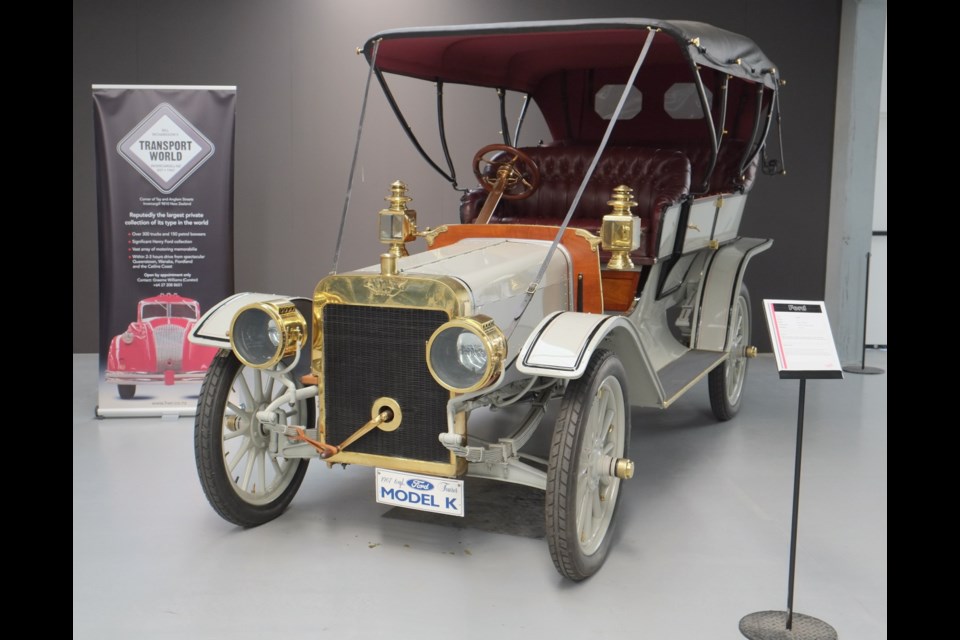The Ford Model K could be called the car that history forgot, and probably Henry Ford himself would rather have forgotten it. It arrived in late 1905 as a 1906 model, and was made until 1908, built almost under protest before Henry Ford gained the iron-fisted control of Ford Motor Co. he would come to enjoy.
The Model K was a large, luxury car with six cylinders when most other luxury makers were still making do with four or fewer. Cadillac, for example, built one-cylinder cars until it added a four in 1905. Peerless got a six in 1908, and Packard in 1912.
When Henry Ford finally got his successful Ford Motor Co. launched in 1903, his third attempt (the first went broke, the second became Cadillac), he did so with the financial backing of wealthy Detroit coal merchant Alexander Malcomson.
In those early days of the automobile, they were usually only affordable by the well-to-do like Malcomson. He was naturally influenced by his circle of friends and contacts and saw luxury cars as the way of the future.
Henry Ford had come from more modest means, having been born on a farm near Dearborn. Although mechanically talented, he was an unsophisticated man with deep suspicions of wealth and power. His idea, like that of Ransom E. Olds of Oldsmobile who was building the popular, small Curved Dash Olds, was that cars should be affordable to the multitudes. And the way to achieve it was to keep them basic and produce them in large numbers.
“The way to make automobiles,” Ford said, “is to make one automobile like another automobile, to make them all alike … just as one pin is like another pin when it comes out of the pin factory.”
This philosophy would come to full fruition in Henry’s beloved Model T Ford, of which more than 15 million were built from 1908 to 1927. It was a single-model record that would stand until 1972 when it was surpassed by the Volkswagen Beetle.
But in 1905, Malcomson’s finances meant he still held the power, and although Ford built light cars such as the two-cylinder Models A and C, Malcomson saw the future in more luxurious cars because more than half of those sold at that time were high-priced models. Thus in 1905, the Ford Motor Co. introduced the Model K.
The Ford Model K was a large luxury car, the opposite of what the Model T would be. It had a big 6.6-litre, 40-horsepower, side-valve, inline six-cylinder engine, one of the earliest American sixes, with a bore and stroke of 114.3 x 108 millimetres.
It was priced at $2,500, later raised to $2,800. This was a large amount of money at that time, although still relatively inexpensive compared with other luxury cars.
Its six iron cylinders were individually cast integrally with their cylinder heads and bolted to the crankcase, as was then common practice. It had a seven-main-bearing crankshaft and drove the rear wheels through a pedal-operated, two-speed planetary transmission that proved marginal for the engine’s power.
Suspension was by longitudinal leaf springs, not the transverse ones for which Ford would become famous. Mechanical brakes operated on the rear wheels.
The K came as a touring car or roadster, with the lighter roadster guaranteed to reach 100 km/h when “a mile a minute” was a performance benchmark. In fact, a Model K driven by Frank Kulick and Bert Lorimer covered 1,827 km in 24 hours for an average of 76 km/h, a world record, proving that the K had both speed and durability.
Henry Ford manoeuvred Malcomson out of Ford in mid-1906, but allowed construction of the K to carry on until 1908, when the Model T arrived to provide transportation for ordinary families.
In spite of the K’s high price, it is unlikely that Ford made any money on it, although it did add a measure of prestige. Sixes were not a favourite of Henry’s, and Ford Motor Co. wouldn’t build another one until 1941.
With the arrival of the Model T, the Model K and others were discontinued and Ford Motor Co. became a one-model company. This lasted for 14 years until 1922, when at the urging of Henry’s son Edsel, titular president of Ford, Ford bought luxury-car company Lincoln out of receivership.
Although never sold in large numbers, and now largely forgotten, today’s market has placed a premium on the Model K as a collectible. Good ones can command prices in the hundreds of thousands of dollars at vintage-car auctions.
Maybe somewhere, Malcomson is having the last laugh.



